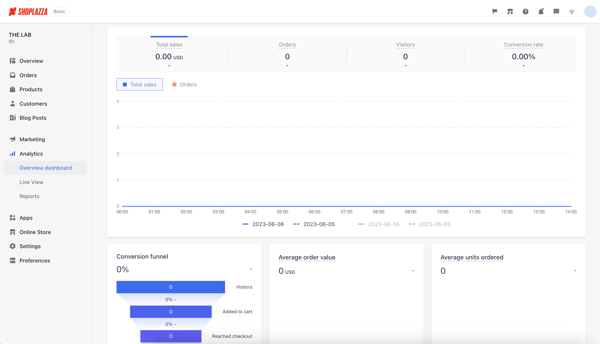
Back in the days of yellow pages and landlines, the key to success was location, location, location. If you had a store on a busy street, you had a much higher chance of keeping those customers coming. Now, if you want your online business to be successful, you need data, data, data. But what kind of data should you be collecting and monitoring?
Ecommerce can be an incredibly competitive market, so understanding and harnessing data is crucial for figuring out how to run your business in the most efficient and effective way. When you track ecommerce metrics, you gain valuable insights into your business’ performance, customer behavior and overall growth.
Don’t know where to begin? No worries. In this article, we’ll tell you everything, from what ecommerce metrics are to which ones you should be focusing on.
First of all, what are ecommerce metrics and KPIs?
Metrics, in the context of ecommerce, refer to the quantitative measurements used to assess various aspects of an online business's performance. They’re numbers that give you a full, in-depth picture of your business and point out ways you can improve your strategy and operations.
Key Performance Indicators (KPIs) are specific metrics that directly reflect a business’s strategic objectives and goals. Basically, you pick specific ecommerce metrics to be your KPIs, the ones you’ll keep an eye on to measure success.
While metrics provide a broader view of performance, KPIs narrow the focus to the most critical factors that impact business success.
Ecommerce metrics and KPIs can help you gauge progress, identify trends and make data-driven decisions. Examples of metrics in ecommerce include conversion rate, average order value, customer lifetime value and many more. We’ll go over these in more detail in a minute.
Why is it important to track ecommerce metrics?
Tracking ecommerce metrics offers several benefits for online businesses:
- Performance evaluation: Ecommerce metrics provide valuable insights into the effectiveness of marketing campaigns, website performance and overall customer engagement.
- Identifying opportunities: By analyzing metrics, ecommerce businesses can identify areas of improvement, optimize their strategies and capitalize on untapped opportunities.
- Data-driven decision-making: Tracking metrics empowers ecommerce businesses to make decisions based on real-time data, not on assumptions or guesswork.
- Monitoring progress: Metrics help monitor progress towards business goals, providing a benchmark for success and enabling course corrections when necessary.
- Competitive advantage: By leveraging ecommerce metrics, businesses can gain a competitive edge by identifying industry trends, staying ahead of other businesses within a niche and adapting to changing market dynamics.
10 ecommerce metrics you need to track
Now that you know what ecommerce metrics are and why they’re so important, we’ve selected 10 metrics you should monitor closely to ensure your ecommerce business is a huge hit.
If you’re a Shoplazza store owner, you can track most of these key ecommerce metrics through your Shoplazza admin. Most Other tools like Google Analytics can help you gain even more insight into your online store and its performance.

Not a Shoplazza store owner yet? Give Shoplazza a go with our 7-day free trial!
Conversion rate
The conversion rate is a super essential metric that tells you the percentage of website visitors who make a purchase. A high conversion rate indicates the effectiveness of marketing efforts, user experience and product offerings.
To improve your conversion rate, you can optimize your website design and navigation, simplify the checkout process, provide clear product descriptions and images, and implement persuasive calls-to-action.
Why this is an important ecommerce metric: Regularly tracking and analyzing the conversion rate allows your ecommerce business to identify bottlenecks and make data-driven optimizations to maximize conversions and revenue.
Average order value (AOV)
The average order value (AOV) measures the average amount customers spend per transaction. It provides valuable insights into customer purchasing behavior and can be a powerful driver of revenue growth.
By increasing the average order value, your business can maximize its profitability and improve its bottom line. Strategies to boost AOV include offering product bundles, cross-selling or upselling relevant items, implementing volume discounts, and providing personalized product recommendations.
Why this is an important ecommerce metric: Analyzing the average order value helps ecommerce businesses identify opportunities for increasing average transaction values and optimizing pricing strategies.
Customer acquisition cost (CAC)
Customer acquisition cost (CAC) refers to the average cost a business incurs to acquire a new customer. It is a critical metric for assessing the efficiency and effectiveness of marketing campaigns and budget allocation.
To calculate CAC, divide the total sales and marketing expenses by the number of brand new customers acquired within a specific time frame. By tracking CAC, businesses can identify cost-effective customer acquisition channels and allocate their marketing budget accordingly.
Lowering CAC can be achieved through optimizing marketing campaigns, targeting specific customer segments, leveraging organic channels and improving the conversion rate.
Why this is an important ecommerce metric: By continuously monitoring CAC, businesses can optimize their customer acquisition strategies and ensure long-term profitability.

Customer lifetime value (CLV)
Customer lifetime value (CLV) predicts the net profit a customer is expected to generate throughout their relationship with the business. It helps ecommerce businesses understand the long-term value of acquiring and retaining customers, allowing for effective customer segmentation and personalized marketing strategies.
To calculate CLV, multiply the average purchase value by the average purchase frequency and multiply the result by the average customer lifespan. A high CLV signifies strong customer loyalty, repeat purchases and a positive customer experience.
Why this is an important ecommerce metric: By analyzing CLV, your ecommerce business can identify high-value customer segments, develop targeted retention strategies and optimize marketing efforts to increase customer lifetime value.
Cart abandonment rate
Cart abandonment rate measures the percentage of visitors who add items to their cart but end up leaving the website without completing the purchase.
By tracking and analyzing this metric, your e-business can identify friction points, such as unexpected shipping costs or complicated checkout procedures, and take steps to optimize the process.
Strategies to reduce cart abandonment include offering transparent pricing, simplifying the checkout process, providing guest checkout options, sending abandoned cart recovery emails, and implementing trust signals, such as security badges.
Why this is an important ecommerce metric: Lowering the shopping cart abandonment rate can significantly impact your online store revenue and improve overall conversion rates.
Website traffic
Website traffic is the number of visitors who access a website within a given time frame. Monitoring website traffic provides insights into the effectiveness of marketing efforts, user engagement and overall brand visibility.
By analyzing website traffic, businesses can identify trends, assess the impact of marketing campaigns, and optimize website content and user experience.
Strategies to increase website traffic include search engine optimization (SEO), content marketing, social media advertising, influencer marketing, and email marketing.
Why this is an important ecommerce metric: Regularly monitoring website traffic allows you to make informed decisions about marketing strategies and identify opportunities for growth.
Return on investment (ROI)
Return on investment (ROI) measures the profitability of marketing campaigns by comparing the cost of investment to the generated revenue. Calculating ROI helps businesses assess the effectiveness and efficiency of their marketing efforts.
If, for instance, you invest $100 on TikTok ads, you need to make sure you’re getting more than $100 back to cover your expenses and generate profit.
To calculate ROI, subtract the total cost of investment from the total revenue generated and divide the result by the total cost of investment. A positive ROI indicates that the marketing campaign has generated more revenue than the investment made.
Why this is an important ecommerce metric: By tracking ROI, you can evaluate the performance of different marketing channels, campaigns and tactics, which allows you to optimize your marketing budget allocation and focus on strategies with the highest returns.
Customer retention rate
Customer retention rate tells you the percentage of people who continue to make purchases from your business over a specific period. A high customer retention rate indicates customer loyalty and satisfaction.
It’s more cost-effective to retain existing customers than to acquire new ones, as loyal customers are inclined to spend more and are much more likely to refer others. Improving customer retention rate can lead to increased customer lifetime value and long-term business growth.
Why this is an important ecommerce metric: By tracking customer retention rate, businesses can identify strategies to improve customer loyalty, such as implementing loyalty programs, offering personalized incentives, providing exceptional customer service and regularly engaging with customers through targeted marketing campaigns.
Email open rate and click-through rate (CTR)
These are two ecommerce metrics that help you figure out the effectiveness of your email marketing campaigns in engaging customers and driving traffic to the website.
Email open rate measures the percentage of recipients who open an email, while click-through rate (CTR) measures the percentage of recipients who click on links within an email.
A high open rate indicates engaging subject lines and strong brand reputation, while a high CTR signifies compelling content and effective call-to-action. To improve your email open rate and CTR, you should consider focusing on personalization, segmentation, compelling content and enticing offers.
Why this is an important ecommerce metric: Tracking these metrics allows businesses to refine their email marketing strategies, optimize campaign performance and drive more traffic and ecommerce sales.
Customer satisfaction score (CSAT)
Customer Satisfaction Score (CSAT) is a metric used to assess customer satisfaction levels. It is typically measured through surveys or feedback gathered from customers. CSAT provides valuable insights into customer experience, product quality and overall satisfaction.
Improving CSAT involves actively listening to customer feedback, promptly addressing issues and continuously striving to exceed customer expectations. A high CSAT score indicates customer loyalty, positive word-of-mouth and a strong brand reputation.
Why this is an important ecommerce metric: By regularly monitoring CSAT, businesses can identify areas for improvement, address customer concerns and enhance the overall customer journey.
Keep a close eye on your ecommerce business
Tracking ecommerce metrics and leveraging KPIs is essential for success in the digital marketplace. By measuring and analyzing these key indicators, your ecommerce store can gain actionable insights, improve strategies and stay ahead of the competition.
The top 10 ecommerce metrics discussed in this article serve as a foundation for businesses to track and monitor their performance, enabling data-driven decision-making and ultimately driving growth. Embracing the power of metrics empowers your ecommerce to thrive in a dynamic and ever-evolving online landscape.



